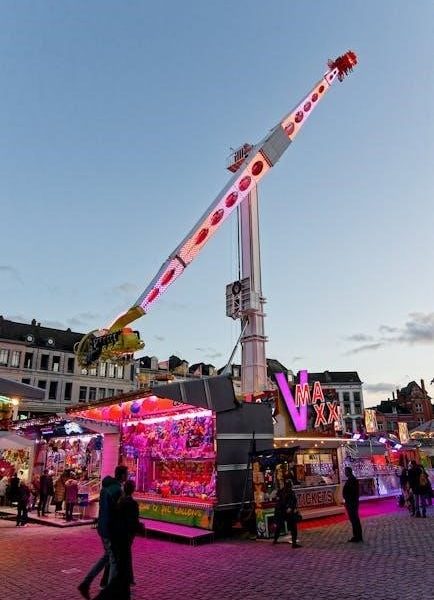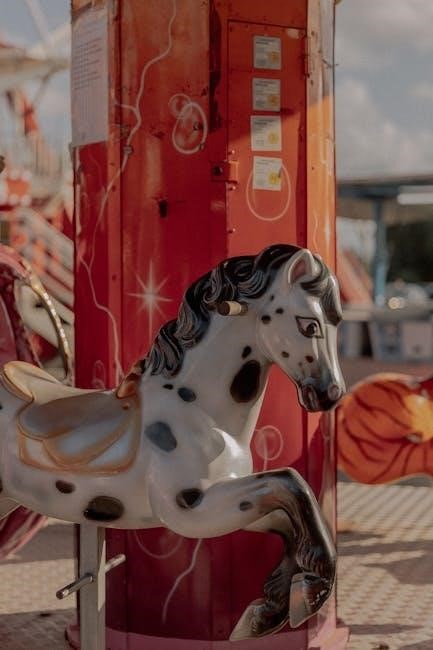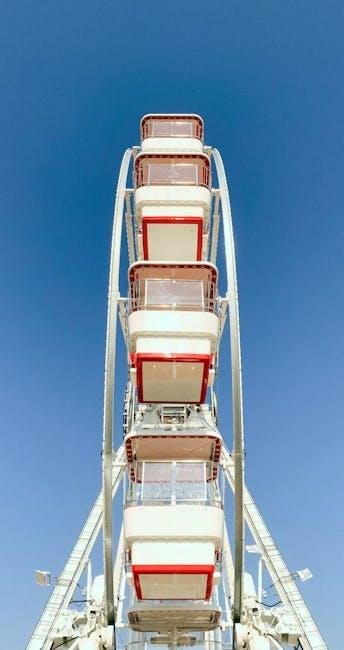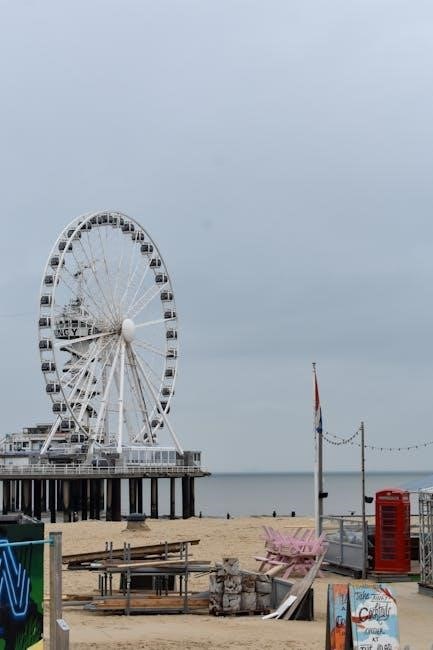ferris wheel knex instructions

Experience the thrill of building a Ferris wheel with Knex, a timeless construction toy that sparks creativity and engineering skills. Perfect for enthusiasts of all ages!
1.1 Overview of Knex and Its Popularity
Knex is a beloved construction toy that fosters creativity and engineering skills through its unique rod-and-connector system. Its popularity stems from its versatility, allowing users to build intricate models like Ferris wheels. Knex sets are cherished by both children and adults, promoting problem-solving and imaginative play. The Ferris wheel, in particular, is a standout project, blending complexity with visual appeal. Its enduring popularity lies in the satisfaction of creating a functional, towering structure that mirrors real-world engineering marvels. Knex continues to inspire builders worldwide, making it a timeless favorite for hands-on learners and hobbyists alike.
1.2 Brief History of Knex Ferris Wheel Models
Knex Ferris wheels have captivated builders for decades, evolving from simple designs to intricate models. Early versions featured basic rod-and-connector frameworks, while modern sets, like the 6-foot Ferris wheel, boast complex mechanisms and motors. These models often include detailed instructions, reflecting Knex’s commitment to innovation. The Ferris wheel’s enduring appeal lies in its blend of art and engineering, offering a challenging yet rewarding project for enthusiasts; Over time, Knex has refined its designs, ensuring that each Ferris wheel model remains a testament to creativity and precision, inspiring builders to push their limits and explore new possibilities in construction and design.
Safety Considerations and Precautions
Ensure all small rods and connectors are kept out of reach of young children. Remove batteries when not in use and avoid inserting small rods into openings. Properly balance the Ferris wheel for smooth operation.
2.1 General Safety Guidelines for Knex Toys
Always follow safety guidelines when building with Knex toys to ensure a safe and enjoyable experience. Keep small rods and connectors out of reach of young children to avoid choking hazards. Avoid inserting small rods into any openings or attempting to bend them excessively, as this may cause breakage. Ensure all components are securely connected to maintain structural integrity. Adult supervision is recommended for children under 8 years old. Regularly inspect the toy for loose parts and ensure proper balance to prevent accidental tipping. Store Knex pieces in a dry, clean environment to preserve their condition.
2.2 Age Recommendations and Adult Supervision
Knex Ferris Wheel sets are recommended for children aged 8 and above due to their complexity and small parts. Adult supervision is strongly advised for younger builders to ensure safety and proper assembly. Parents or guardians should guide children in understanding instructions and handling intricate components. This collaborative approach not only enhances learning but also ensures the toy is used safely and effectively. Encourage children to participate actively while providing assistance for challenging steps, fostering both creativity and responsibility. Always prioritize supervision to prevent accidents and promote a enjoyable building experience.

Gathering Materials and Tools
Ensure you have all necessary Knex pieces, including rods, connectors, and spacers. Gather essential tools like screwdrivers and Allen wrenches. Organize materials for efficient assembly.
3.1 List of Required Knex Pieces for the Ferris Wheel
To assemble a Knex Ferris wheel, you’ll need a variety of pieces, including rods of different lengths, connectors (both blue and gray), and spacers. Gears, motor components, and clips are also essential for functionality. Ensure you have an adequate supply of these parts, as they form the structural and mechanical backbone of the Ferris wheel. Refer to the official instructions for a detailed count and specifications to avoid missing any critical components during assembly.
3.2 Essential Tools for Assembly
Building a Knex Ferris wheel requires specific tools to ensure a smooth assembly process. A flat-head screwdriver is necessary for tightening connections, while an Allen wrench helps secure gears and motor parts. A clamp or vice can hold sections steady, preventing movement during construction. A rubber mallet may be useful for gently tapping pieces into place without causing damage. Additionally, a work mat or flat surface is essential for organizing and keeping track of small components. Optional tools include wire cutters for customizing rods and a diagram stand to keep instructions visible.

Understanding Knex Building Basics
Mastering Knex basics involves understanding rods, connectors, and spacers, which form the foundation of all structures, including the Ferris wheel’s frame and mechanical systems.
4.1 Overview of Knex Connectors and Spacers
Knex connectors come in various colors, such as blue and gray, each designed for specific functions. They attach to rods, enabling secure connections at angles, while spacers maintain precise distances between parts. Properly aligning connectors ensures structural integrity, and experimenting with different configurations can enhance stability. Understanding these components is essential for building complex models like the Ferris wheel, where precise connections are critical for smooth operation and durability.
4.2 How to Use Rods and Gears Effectively
Rods are the backbone of Knex structures, providing stability and support. Use longer rods for framework and shorter ones for detailing. Gears are essential for transferring motion, especially in the Ferris wheel’s rotation. Align gears properly to ensure smooth operation and avoid jams. Secure rods and gears firmly with connectors to prevent wobbling. Experiment with gear ratios to control speed and torque. Proper placement and alignment of these components are key to achieving a functional and durable Ferris wheel design.

Step-by-Step Assembly Guide
Construct the base, frame, and seats step-by-step. Attach the motor and ensure all parts are secure. Follow instructions carefully for a smooth build experience.
5.1 Building the Base and Support Structure
Start by constructing a sturdy base using flat Knex pieces and connectors. Attach vertical rods to create the support structure, ensuring it is level and stable.
Use spacers to maintain even spacing between rods for proper alignment. Connect the base to the support frame securely to prevent wobbling.
This foundation is crucial for the Ferris wheel’s stability and smooth operation. Follow the instructions carefully to ensure all pieces fit tightly together.
Once the base and support are complete, you can proceed to build the Ferris wheel frame and add the necessary components.
5.2 Constructing the Ferris Wheel Frame
Begin by attaching the rods to the connectors to form the circular frame of the Ferris wheel. Ensure each rod is securely inserted into the appropriate slots.
Use spacers to maintain proper alignment and spacing between the rods. This step is critical for achieving a smooth, balanced rotation.
Once the frame is complete, carefully lift and attach it to the base and support structure. Double-check the balance to ensure the wheel is level and even.
Tighten all connections firmly to prevent any movement or wobbling during operation. A sturdy frame is essential for the Ferris wheel to function smoothly and safely.
5.3 Adding Seats and Passenger Cars
Attach the passenger cars to the Ferris wheel frame by connecting them to the designated slots using small clips or connectors.
Ensure each car is securely fastened to prevent loose parts during rotation.
Add seats and small figures inside the cars for a more realistic appearance.
Balance the cars evenly around the wheel to maintain smooth operation.
Double-check all connections to ensure stability and proper alignment.
Once complete, test the Ferris wheel by gently spinning it to confirm the cars move smoothly and remain secure.
5.4 Installing the Motor and Drive System
Attach the motor to the base of the Ferris wheel using the provided brackets or connectors.
Align the motor’s drive shaft with the axle of the wheel to ensure proper rotation.
Secure the motor firmly to prevent any movement during operation.
Connect the power source, such as batteries, to the motor and test the rotation at a slow speed.
Adjust the motor’s alignment if necessary to achieve smooth and consistent spinning.
Ensure all gears and connections are tightly fitted to avoid slippage or noise during operation.

Tips for Smooth Operation
Ensure the Ferris wheel is evenly balanced and all connections are secure. Maintain a smooth circular shape and tighten any loose parts for optimal performance.
6.1 Ensuring Proper Balance of the Wheel
Proper balance is crucial for smooth operation. Ensure the Ferris wheel is symmetric and evenly weighted. Check that all parts are securely connected and evenly distributed. Use a level to confirm the base is stable. If the wheel wobbles, adjust the frame or tighten loose connections. Ensure the motor is aligned correctly to avoid uneven rotation. Regularly inspect and adjust the balance during assembly to maintain stability and prevent misalignment. A well-balanced wheel will spin smoothly, enhancing the overall performance of your Knex Ferris wheel model.
6.2 Adjusting and Securing Connections
Securing connections is vital for the Ferris wheel’s stability and functionality. Tighten all rods and connectors firmly to prevent wobbling. Ensure tan clips and gray connectors are properly aligned and seated. Use spacers to maintain even spacing between parts. Regularly inspect and tighten any loose connections during assembly. Pay special attention to the drive system and motor alignment to ensure smooth operation. Properly secured connections will minimize wobbling and ensure the Ferris wheel operates seamlessly. Always double-check the alignment of the wheel’s frame and seats for optimal performance and safety.

Troubleshooting Common Issues
Identify and resolve common problems like the Ferris wheel not spinning or parts being misaligned. Check balance, connections, and alignment for smooth operation.
7.1 Why the Ferris Wheel Might Not Spin
If your Ferris wheel isn’t spinning, check if the motor is securely connected and powered. Ensure all rods and connectors are tightly fitted. Misaligned or loose parts can prevent smooth rotation. Verify that the drive system is properly engaged and that no obstructions are blocking the wheel. Additionally, make sure the wheel is balanced evenly, as an imbalance can cause friction and hinder movement. Consult the manual for specific troubleshooting steps if issues persist.

7.2 Fixing Wobbly or Misaligned Parts
If your Ferris wheel has wobbly or misaligned parts, inspect the connections and tighten any loose rods or connectors. Ensure spacers are correctly placed to maintain structural integrity. Check for bent or warped components and replace them if necessary. Realign the frame by adjusting the joints and verifying that all pieces fit snugly together. For severe misalignment, disassemble the affected section and rebuild it carefully. Proper alignment ensures smooth operation and prevents further issues. Always refer to the manual for guidance on specific parts and their placement.

Space and Setup Requirements
Ensure a clear, flat surface for assembly, with enough space to accommodate the Ferris wheel’s height and width. A stable area prevents wobbling during construction and operation.
8.1 Recommended Area for Assembly
For optimal assembly, choose a spacious, flat, and stable surface. A 6ft by 6ft area is ideal for larger Ferris wheel models to accommodate height and width. Ensure the space is clear of obstacles to prevent lost parts. Avoid uneven surfaces, as they may cause instability during construction. Consider assembling on a soft surface, like a carpet, to protect pieces from damage. Ensure good lighting and minimal distractions for focus. Gather all tools and parts nearby to streamline the process. Proper spacing ensures smooth assembly and prevents accidental damage to the structure.
8.2 Height and Width Considerations
Ensure your space accommodates the Ferris wheel’s full height and width. Larger models like the 6ft Ferris wheel require at least 6ft of vertical space and 6ft of width. Measure your assembly area to confirm fitment. Consider ceiling height if assembling indoors. Outdoor setups offer more flexibility but ensure the ground is level. Adequate clearance prevents collisions and allows easy access for adjustments. Proper measurements ensure the Ferris wheel operates smoothly and safely, avoiding damage or instability during operation.

Customization and Advanced Techniques
Elevate your Knex Ferris wheel by adding lights or decorations for a unique look. Explore advanced techniques to modify the design, creating one-of-a-kind features that showcase creativity and innovation.
9.1 Adding Lights or Other Decorations
Enhance your Knex Ferris wheel with creative decorations like LED lights, glow sticks, or string lights to create a vibrant display. Use small, secure attachments to add these elements without compromising the structure. Paint or stickers can also add color and personality. Consider themed decorations, such as a circus or carnival theme, to make the Ferris wheel more visually appealing. Ensure all additions are safely secured to avoid obstructing movement; This step allows you to personalize your creation, making it truly unique and eye-catching while maintaining functionality.
9.2 Modifying the Design for Unique Features
Take your Knex Ferris wheel to the next level by incorporating unique features. Add glow-in-the-dark details or small LED lights for a vibrant nighttime effect. Experiment with custom paint or stickers to personalize the design. Consider adding movable seats or interactive elements, like a ticket booth, to enhance realism. For advanced builders, integrate motorized components or synchronize the wheel’s rotation with music. These modifications allow you to express creativity while maintaining the structural integrity of the Ferris wheel. The possibilities are endless, making each build a one-of-a-kind masterpiece.

Resources for Further Assistance
Access official Knex manuals for detailed Ferris wheel instructions. Visit online forums and communities for troubleshooting tips and creative ideas from experienced Knex enthusiasts worldwide.
10.1 Where to Find Official Knex Manuals
Official Knex manuals are available for download on trusted websites like manuall.co.uk and knex.parts. These platforms offer free PDF downloads for specific sets, including Ferris wheel models. Simply search for your set number, such as 12078 or 89790, and follow the download instructions. Ensure you verify the manual’s compatibility with your set to avoid confusion. If the manual isn’t available online, contact Knex directly through their official website or customer support for assistance. Always prioritize official sources to guarantee accurate and reliable instructions for your Knex Ferris wheel project.
10.2 Online Communities and Forums for Knex Enthusiasts
Join vibrant online communities like Knex.parts and enthusiast forums to connect with fellow builders. These platforms offer troubleshooting tips, shared experiences, and creative ideas for your Ferris wheel projects; Engage with experts, ask questions, and showcase your creations. Many users share detailed step-by-step guides and modifications, providing invaluable insights. Participating in these forums can enhance your building skills and inspire new designs. Don’t hesitate to reach out for advice or collaboration, fostering a sense of camaraderie among Knex enthusiasts worldwide.
Congratulations! You’ve successfully built your Knex Ferris Wheel. Enjoy the fruits of your labor and consider sharing your creation with fellow enthusiasts online for inspiration and feedback.
11.1 Final Tips for Successful Assembly
For a seamless Knex Ferris Wheel assembly, ensure all parts are organized and easily accessible. Follow the manual step-by-step, double-checking each connection for stability. Maintain patience, as precision is key to smooth operation. Regularly inspect and tighten loose parts. If issues arise, refer to troubleshooting guides or online forums for solutions. Practice makes perfect—don’t hesitate to disassemble and adjust if needed. Finally, consider customizing your Ferris Wheel with lights or unique designs for a personalized touch. Happy building!
11.2 Encouragement to Experiment and Create
Embrace creativity and experiment with your Knex Ferris Wheel design! Try adding lights, unique shapes, or personalized touches to make it stand out. Explore online communities for inspiration and tips from fellow builders. Remember, there’s no right or wrong way to build—every modification is an opportunity to learn and innovate. Don’t be afraid to try new techniques or adjust designs to suit your vision. Building with Knex fosters problem-solving skills and creativity, so let your imagination run wild and enjoy the journey of bringing your ideas to life!